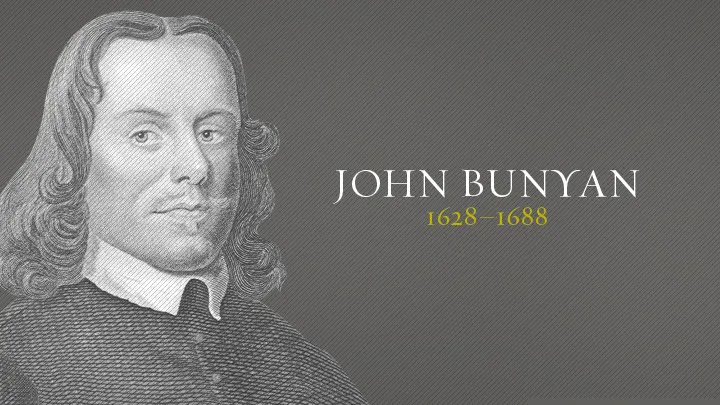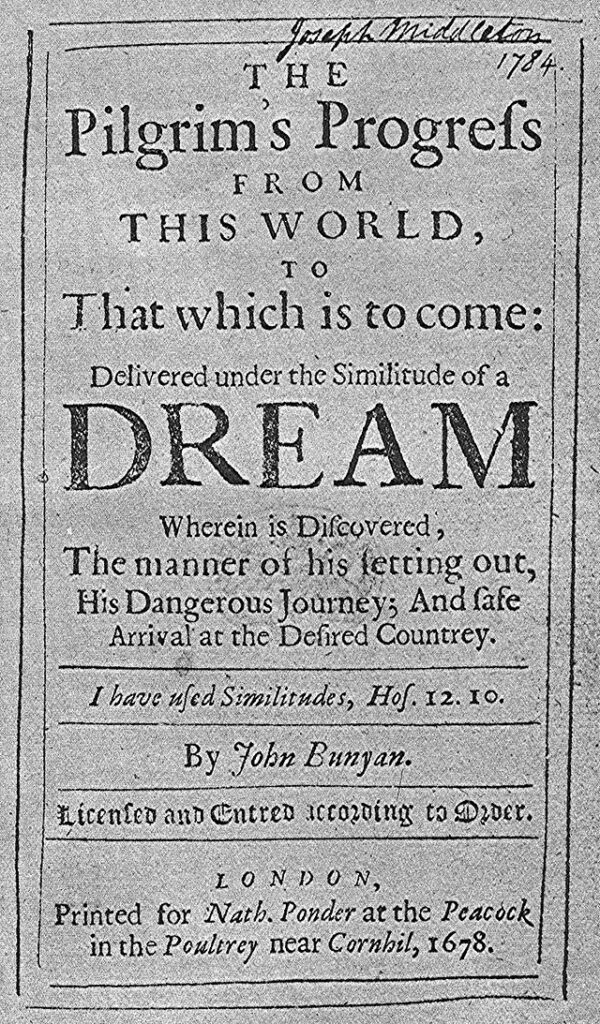John Bunyan was born in 1628 to Thomas and Margaret Bunyan at Bunyan’s End in the parish of Elstow, Bedfordshire. Bunyan’s End is about halfway between the hamlet of Harrowden (one mile south-east of Bedford) and Elstow High Street. Bunyan’s date of birth is not known, but he was baptised on 30 November 1628, the baptismal entry in the parish register reading “John the sonne of Thomas Bunnion Jun., the 30 November”. The name Bunyan was spelt in many ways (there are 34 variants in Bedfordshire Record Office) and probably had its origins in the Norman-French name Buignon. There had been Bunyans in Bedfordshire since at least 1199.
Bunyan’s father was a brazier or tinker who travelled around the area mending pots and pans, and his grandfather had been a chapman or small trader. The Bunyans had owned land and properties in Elstow, so Bunyan’s origins were not quite as humble as one might assume from his autobiographical work Grace Abounding to the Chief of Sinners where he wrote that his father’s house was “of that rank that is meanest and most despised in the country”.
As a child Bunyan learned his father’s trade of tinker and was given some schooling but it is not known which school he attended. In the summer of 1644 Bunyan lost both his mother and his sister Margaret. That autumn, shortly before or after his sixteenth birthday, Bunyan enlisted in the Parliamentary army when an edict demanded 225 recruits from the town of Bedford. There are few details available about his military service, which took place during the first stage of the English Civil War.

Bunyan spent nearly three years in the army, leaving in 1647 to return to Elstow and his trade as a tinker. His father had remarried and had more children and Bunyan moved from Bunyan’s End to a cottage in Elstow High Street.
Within two years of leaving the army, Bunyan married. The name of his wife and the exact date of his marriage are not known, but Bunyan did recall that his wife, a pious young woman, brought with her into the marriage two books that she had inherited from her father: Arthur Dent‘s Plain Man’s Pathway to Heaven and Lewis Bayly‘s Practice of Piety. He also recalled that, apart from these two books, the newly-weds possessed little: “not having so much household-stuff as a Dish or a Spoon betwixt us both”. The couple’s first daughter, Mary, was born in 1650, and it soon became apparent that she was blind. They would have three more children, Elizabeth, Thomas and John.
By his own account, Bunyan had as a youth enjoyed bell-ringing, dancing and playing games including on Sunday, which was forbidden by the Puritans, who held a particularly high view of Sunday, called the Lord’s Day. One Sunday the vicar of Elstow preached a sermon against Sabbath breaking, and Bunyan took this sermon to heart. That afternoon, as he was playing tip-cat (a game in which a small piece of wood is hit with a bat) on Elstow village green, he heard a voice from the heavens “Wilt thou leave thy sins, and go to Heaven? Or have thy sins, and go to Hell?” The next few years were a time of intense spiritual conflict for Bunyan as he struggled with his doubts and fears over religion and guilt over what he saw as his state of sin.
During this time Bunyan, whilst on his travels as a tinker, happened to be in Bedford and pass a group of women who were talking about spiritual matters on their doorstep. The women were in fact some of the founding members of the Bedford Free Church or Meeting and Bunyan, who had been attending the parish church of Elstow, was so impressed by their talk that he joined their church. At that time the nonconformist group was meeting in St John’s church in Bedford under the leadership of former Royalist army officer John Gifford. At the instigation of other members of the congregation Bunyan began to preach, both in the church and to groups of people in the surrounding countryside. In 1656, having by this time moved his family to St Cuthbert’s Street in Bedford, he published his first book, Gospel Truths Opened, which was inspired by a dispute with Ranters and Quakers. In 1658 Bunyan’s wife died, leaving him with four small children, one of them blind. A year later he married an eighteen-year-old woman named Elizabeth.
The religious tolerance which had allowed Bunyan the freedom to preach became curtailed with the restoration of the monarchy in 1660. The members of the Bedford Meeting were no longer able to meet in St John’s church, which they had been sharing with the Anglican congregation. That November, Bunyan was preaching at Lower Samsell, a farm near the village of Harlington, thirteen miles from Bedford, when he was warned that a warrant was out for his arrest. Deciding not to make an escape, he was arrested and brought before the local magistrate Sir Francis Wingate, at Harlington House. Bunyan was arrested under the Conventicle Act of 1593, which made it an offence to attend a religious gathering other than at the parish church with more than five people outside their family. The offence was punishable by 3 months’ imprisonment followed by banishment or execution if the person then failed to promise not to re-offend.
The trial of Bunyan took place in January 1661 at the quarter sessions in Bedford, before a group of magistrates under John Kelynge, who would later help to draw up the Act of Uniformity. Bunyan, who had been held in prison since his arrest, was indicted of having “devilishly and perniciousy abstained from coming to church to hear divine service” and having held “several unlawful meetings and conventicles, to the great disturbance and distraction of the good subjects of this kingdom”. He was sentenced to three months imprisonment with transportation to follow if at the end of this time he did not agree to attend the parish church and desist from preaching.
As Bunyan refused to agree to give up preaching, his period of imprisonment eventually extended to 12 years and brought great hardship to his family. Elizabeth, who made strenuous attempts to obtain his release, had been pregnant when her husband was arrested and she subsequently gave birth prematurely to a still-born child.
Bunyan spent his 12 years’ imprisonment in Bedford County Gaol, which stood on the corner of the High Street and Silver Street. There were however occasions when he was allowed out of prison, depending on the gaolers and the mood of the authorities at the time, and he was able to attend the Bedford Meeting and even preach. His daughter Sarah was born during his imprisonment (the other child of his second marriage, Joseph, was born after his release in 1672).
In prison, Bunyan had a copy of the Bible and of John Foxe‘s Book of Martyrs, as well as writing materials. He also had at times the company of other preachers who had been imprisoned. It was in Bedford Gaol that he wrote Grace Abounding and started work on The Pilgrim’s Progress, as well as penning several tracts that may have brought him a little money. In 1671, while still in prison, he was chosen as pastor of the Bedford Meeting. By that time there was a mood of increasing religious toleration in the country and in March 1672 the king issued a declaration of indulgence which suspended penal laws against nonconformists. Thousands of nonconformists were released from prison, amongst them Bunyan and five of his fellow inmates of Bedford Gaol. Bunyan was freed in May 1672 and immediately obtained a licence to preach under the declaration of indulgence.
Following his release from jail in 1672 Bunyan probably did not return to his former occupation of a tinker. Instead, he devoted his time to writing and preaching. He continued as pastor of the Bedford Meeting and travelled over Bedfordshire and adjoining counties on horseback to preach, becoming known affectionately as “Bishop Bunyan”. His preaching also took him to London, where Lord Mayor Sir John Shorter became a friend and presented him with a silver-mounted walking stick. The Pilgrim’s Progress was published in 1678 by Nathaniel Ponder and immediately became popular, though probably making more money for its publisher than for its author.
Two events marred Bunyan’s life during the later 1670s. Firstly he became embroiled in a scandal concerning a young woman called Agnes Beaumont. When going to preach in Gamlingay in 1674 he allowed Beaumont, a member of the Bedford Meeting, to ride pillion on his horse, much to the anger of her father, who then died suddenly. His daughter was initially suspected of poisoning him, though the coroner found he had died of natural causes. In 1676-7 he underwent a second term of imprisonment, probably for refusing to attend the parish church. This second imprisonment lasted six months.
In 1688, on his way to London, Bunyan made a detour to Reading, Berkshire, to try and resolve a quarrel between a father and son. Continuing to London to the house of his friend, grocer John Strudwick of Snow Hill in the City of London, he was caught in a storm and fell ill with a fever. He died in Strudwick’s house on the morning of 31 August 1688 and was buried in the tomb belonging to Strudwick in Bunhill Fields nonconformist burial ground in London. Bunyan’s estate at his death was worth £42 19s 0d (about £5,200 in today’s economy). His widow Elizabeth died in 1691.
Between 1656, when he published his first work, Some Gospel Truths Opened (a tract against the Ranters and Quakers—who at the time were somewhat indistinguishable), and his death in 1688, Bunyan published 42 titles. A further two works, including his Last Sermon, were published the following year by George Larkin. In 1692 Southwark comb-maker

Charles Doe, who was a friend of Bunyan’s later years, brought out, with the collaboration of Bunyan’s widow, a collection of the author’s works, including 12 previously unpublished titles, mostly sermons. Six years later Doe published The Heavenly Footman and finally in 1765 Relation of My Imprisonment was published, giving a total of 58 published titles.
Bunyan is best remembered for The Pilgrim’s Progress, a book which gained immediate popularity. By 1692, four years after the author’s death, publisher Charles Doe estimated that 100,000 copies had been printed in England, as well as editions “in France, Holland, New England and Welch”. By 1938, 250 years after Bunyan’s death, more than 1,300 editions of the book had been printed.
During the 18th century Bunyan’s unpolished style fell out of favour, but his popularity returned with Romanticism, poet Robert Southey writing a lengthy appreciative biography in 1830 to accompany an edition of The Pilgrim’s Progress that many critics deem a turning point in Bunyan scholarship.[45] Bunyan’s reputation was further enhanced by the evangelical revival and he became a favourite author of the Victorians.[46] The tercentenary of Bunyan’s birth, celebrated in 1928, elicited praise from his former adversary, the Church of England.[47] Although popular interest in Bunyan waned during the second half of the twentieth century, academic interest in the writer has increased and Oxford University Press brought out a new edition of his works, beginning in 1976.
Check out other blogs.
